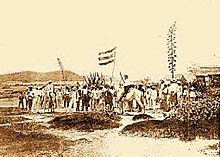| Intentona de Yauco | |||||||
|---|---|---|---|---|---|---|---|
| Part of the Independence movement in Puerto Rico | |||||||
 Intentona de Yauco, c. 1897 | |||||||
| |||||||
| Belligerents | |||||||
|
| |||||||

The Intentona de Yauco (Attempted Coup of Yauco) of March 24–26, 1897 was the second and final short-lived revolt against Spanish rule in Puerto Rico. It was staged by the pro-independence Revolutionary Committee of Puerto Rico in the southwestern municipality of Yauco, 29 years after the first unsuccessful revolt, known as the Grito de Lares (Cry of Lares). During the Intentona de Yauco, the current flag of Puerto Rico was flown on the island for the first time.
The first major revolt in 1868 is known as El Grito de Lares. After the failure of this short-lived rebellion, many of the local leaders and participants were arrested, and some were executed. Those who survived their prison terms were later released and some went into exile, especially in New York City.
Shortly after the 1868 revolt, Spain gave the island many liberal reforms. It extended to Puerto Rico some elements of the liberal constitution that it had allowed its former colonies in South America. Political reforms included allowing Puerto Ricans to participate in special elections and to organize officially recognized political parties.[1] During the following years, the minor protests against centralist rule that arose in various towns of the island were quickly subdued by the authorities.
Leaders of El Grito de Lares who were in exile in New York City joined the Puerto Rican Revolutionary Committee, founded on December 8, 1895 to continue the quest for independence. In 1897, with the aid of the local leaders of the independence movement of the town of Yauco, they organized another uprising, which became known as the Intentona de Yauco. The local autonomist political factions, which believed that such an attempt would be a threat to their struggle for political autonomy, opposed such an action. Rumors of the planned event spread to the local authorities, who acted swiftly and put an end to what would be the last major uprising in the island to Spanish centralist rule.[2]
- ^ "Grito de Lares", El Boricua
- ^ "Historia militar de Puerto Rico"; Héctor Andrés Negroni; Sociedad Estatal Quinto Centenario; 1992, Spanish, ISBN 978-84-7844-138-9